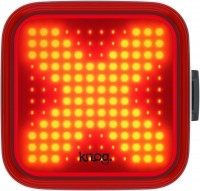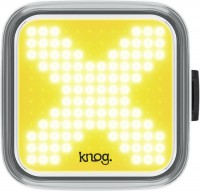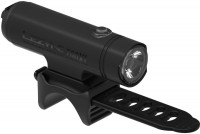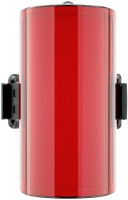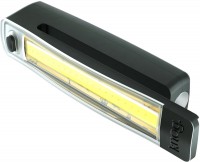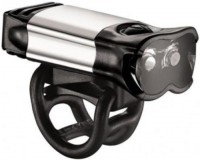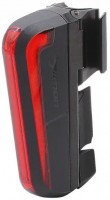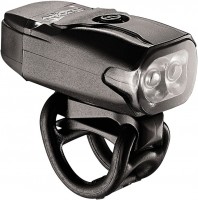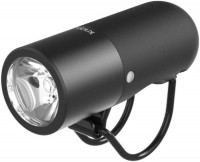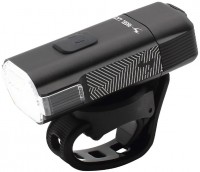Bike Lights Knog
All Bike Lights Advanced filters → |
You might be interested in
Bike Lights: specifications, types
Type
The type determines the purpose and configuration of the lantern.
— Velofara. A device similar to car headlights and designed to illuminate the road in front of the cyclist, as well as to increase its visibility. In many countries, the use of a bicycle headlight at night or in low visibility conditions is mandatory; and even if there is no such prescription in the law, driving without lights in poor visibility is simply unwise and unsafe. The headlight, usually, is mounted on the ste...ering wheel and rotates with it; many of these devices have a strobe mode to further improve visibility.
— Flasher. Auxiliary lamp mounted at the rear of the bicycle. Usually, flashing lights are made red (although there are other colours) and are not intended for lighting, but solely to make the cyclist more visible to other road users. Unlike headlights, such equipment is rarely mandatory even at night, however, from the point of view of traffic safety, it is much more effective and preferable than simple reflectors (reflectors). Note that, despite the name, flashers do not necessarily work only in flashing mode — usually, the design also provides for a constant light mode.
— Velofara + flasher. A kit that includes both of the devices described above — a bicycle headlight and a flasher. The point of this option is that the cyclist can purchase both the front and rear lights at once, instead of buying them one at a time. On the other hand, buying separately gives you the opportunity to choose the lights at your discretion, while in this case you have to rely on the decision of the manufacturer. Therefore, the “bicycle headlight + flasher” kits have not received much distribution.
— Velofara. A device similar to car headlights and designed to illuminate the road in front of the cyclist, as well as to increase its visibility. In many countries, the use of a bicycle headlight at night or in low visibility conditions is mandatory; and even if there is no such prescription in the law, driving without lights in poor visibility is simply unwise and unsafe. The headlight, usually, is mounted on the ste...ering wheel and rotates with it; many of these devices have a strobe mode to further improve visibility.
— Flasher. Auxiliary lamp mounted at the rear of the bicycle. Usually, flashing lights are made red (although there are other colours) and are not intended for lighting, but solely to make the cyclist more visible to other road users. Unlike headlights, such equipment is rarely mandatory even at night, however, from the point of view of traffic safety, it is much more effective and preferable than simple reflectors (reflectors). Note that, despite the name, flashers do not necessarily work only in flashing mode — usually, the design also provides for a constant light mode.
— Velofara + flasher. A kit that includes both of the devices described above — a bicycle headlight and a flasher. The point of this option is that the cyclist can purchase both the front and rear lights at once, instead of buying them one at a time. On the other hand, buying separately gives you the opportunity to choose the lights at your discretion, while in this case you have to rely on the decision of the manufacturer. Therefore, the “bicycle headlight + flasher” kits have not received much distribution.
Smart lighting
The presence in the headlight of "smart" control electronics, providing various advanced features. So, bike lights with smart lighting are usually able to adapt to the speed of movement: the faster the cyclist rides, the farther the headlight shines. Such a device receives speed data from a bike computer or other control gadget. The rear “flasher” with this feature can be synchronized with the brakes and, when braking, turn on at maximum brightness, playing the...role of a brake light. Another possibility found in "smart" lamps is wireless remote control. Thanks to this, you can give commands to the headlight from the remote control on the handlebars, as well as turn the lights on and off at a certain distance from the bike. Other functions may be provided, depending on the model. Among the disadvantages of such devices, in addition to the high cost, one can name the fact that a compatible external gadget may be needed for operation.
LED
The number of individual light emitting diodes (LED) in the bike light (see "Type").
A larger number of LEDs, on the one hand, makes it possible to achieve greater brightness of the headlight and reduces the likelihood of its complete failure (the failure of one LED does not lead to a loss of lamp operation). On the other hand, the technical features of modern LEDs are such that manufacturers prefer to put one bright single-chip LED instead of several case ones into powerful “long-ra...nge” bicycle lights. On the third, there can also be several single-chip LEDs, to increase reliability and provide additional adjustments (for example, changing the brightness by turning on / off individual LEDs). Therefore, only lamps of the same price category should be compared by this parameter. At the same time, “multiple-charged” models, in addition to the described advantages, also have disadvantages — they are, usually, more complicated, more expensive and larger.
A larger number of LEDs, on the one hand, makes it possible to achieve greater brightness of the headlight and reduces the likelihood of its complete failure (the failure of one LED does not lead to a loss of lamp operation). On the other hand, the technical features of modern LEDs are such that manufacturers prefer to put one bright single-chip LED instead of several case ones into powerful “long-ra...nge” bicycle lights. On the third, there can also be several single-chip LEDs, to increase reliability and provide additional adjustments (for example, changing the brightness by turning on / off individual LEDs). Therefore, only lamps of the same price category should be compared by this parameter. At the same time, “multiple-charged” models, in addition to the described advantages, also have disadvantages — they are, usually, more complicated, more expensive and larger.
Output
Luminous flux given out by a bicycle headlight (see "Type"); in models with adjustable brightness, usually, the maximum value is indicated.
The higher the luminous flux, the brighter the headlight and the greater the illumination range (see below). On the other hand, this characteristic significantly affects the dimensions, weight and cost of the flashlight, despite the fact that high brightness is not always required — for example, for episodic tri...ps along well-lit city streets, a powerful flashlight is not needed. Therefore, it is worth choosing a bicycle headlight according to the luminous flux, taking into account the features of the planned application; specific recommendations for different cases (city, highway, rough terrain, etc.) can be found in special sources. Also, do not forget that the actual lighting efficiency depends not only on the brightness, but also on the shape of the light spot.
The higher the luminous flux, the brighter the headlight and the greater the illumination range (see below). On the other hand, this characteristic significantly affects the dimensions, weight and cost of the flashlight, despite the fact that high brightness is not always required — for example, for episodic tri...ps along well-lit city streets, a powerful flashlight is not needed. Therefore, it is worth choosing a bicycle headlight according to the luminous flux, taking into account the features of the planned application; specific recommendations for different cases (city, highway, rough terrain, etc.) can be found in special sources. Also, do not forget that the actual lighting efficiency depends not only on the brightness, but also on the shape of the light spot.
Illumination range
The greatest range at which a bicycle headlight (see "Type") provides effective illumination. The criteria for what is considered effective lighting are very arbitrary and may be different for different manufacturers; therefore this figure is approximate. Nevertheless, it allows you to fairly accurately assess the effectiveness of the flashlight and is more visual than the value of the luminous flux (see above). It is also worth choosing a bicycle headlight according to the range, taking into ac...count the intended application; here note that in some (especially inexpensive) models, “range” can be achieved by narrowing the beam and, accordingly, reducing the light spot.
Operating modes
The number of individual operating modes provided in the bike headlight (see "Type"). Usually, this parameter takes into account all available adjustments: for example, for a model with 3 brightness adjustments and the ability to work in the stroboscope format, 6 modes will be indicated (3 brightness values \u200b\u200bfor constant light and the same for a stroboscope). A specific set of modes in each case should be clarified separately, but in general, the more there are, the more options for u...se the headlight suggests, the higher the likelihood that an unforeseen situation will not take the owner by surprise.

